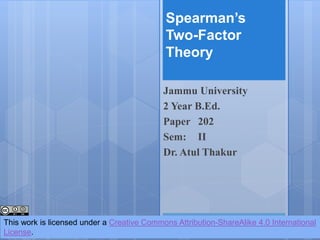
Spearman 2 factor theory
- 1. Spearman’s Two-Factor Theory Jammu University 2 Year B.Ed. Paper 202 Sem: II Dr. Atul Thakur This work is licensed under a Creative Commons Attribution-ShareAlike 4.0 International License.
- 2. Spearman’s Two-Factor Theory: The English psychologist, Charles Spearman (1863-1945), in 1904 proposed his theory of intelligence called two-factor theory. According to him intellectual abilities are comprised of two factors, namely the general ability known as G-factor and specific Abilities known as S-factors.
- 3. The performance by the individual is determined by the G-factor and the S-factors. The total intelligence of the individual is the sum total of the G-factor and the S-factors. The performance of a particular task depends on the ‘G’ factor or general ability and the particular ‘S’ factor or specific ability.
- 4. Characteristics of ‘G’ Factor: It is universal inborn ability. It is general mental energy. It is constant. The amount of ‘g’ differs from individual to individual. It is used in every activity of life. Greater the ‘g’ in an individual, greater is his success in life.
- 5. Characteristics of ‘S’ Factor: It is learned and acquired in the environment. It varies from activity to activity in the same individual. Individuals differ in the amount of ‘S’ ability.
- 6. ‘G’ factor represents Native Intelligence thus when we respond to any situation or perform an intellectual task, our general mental ability or ‘G’ factor is mainly responsible for it and our specific ability in that particular task is responsible for the rest. There are a large number of specific abilities such as ability to draw inferences, ability to complete sentences, ability to code message etc.
- 7. Spearman’s Two-Factor Theory or Eclectic Theory G S1 S2 S3 S4
- 8. Different individuals differed both in their ‘G’ as well as ‘S’ factors. For e.g. an individual’s performance in literature is partly due to his general intelligence and partly due some specific aptitude for his language, i.e. G+S1. In mathematics his performance may be the result of G+S2. In drawing, it may be due to G+S3 and in social sciences; it may be due to G+S4 and so on. Thus the factor ‘G’ is present in all specific activities.
- 9. Educational Implications and relevance of Spearman’s Two –Factor Theory 1. The theory gives a better insight to the teacher about the nature of intelligence. 2. The general ability differs from individual to individual. 3. The specific abilities also differ from individual to individual. 4. ‘S’ factor varies in degrees. Therefore, it can be modified by learning or habitual training
- 10. 5. A child requires different amounts of ‘G’ and ‘S’ factors for achieving success in different Subjects. 6. We require a high quality of ‘G’ factor for our success in life. 7. Both ‘G’ and ‘S’ have a high correlation. 8. This theory could be used to guide, construction of a set of ability test
